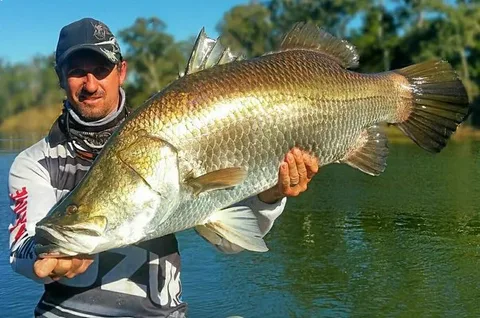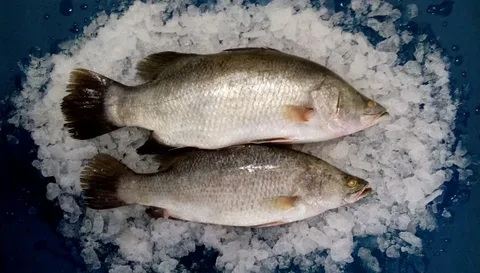The barramundi (Lates calcarifer), the Asian sea bass, big sea perch, or dangri, is a catadromous fish from the family Latidae of the order Perciformes. The species lives in the Indo-West Pacific, including the Near East, South Asia, Southeast Asia, East Asia, and Oceania.
Animal name origin
Barramundi is a loanword from an Australian Aboriginal language spoken in the Rockhampton area of Queensland, which means “large-scaled river fish”. Originally, the term barramundi applied to both Scleropages leichardti and Scleropages jardinii.
Where Are Barramundi Found?
Sustainable barramundi are raised in land-based tanks and pond. There are less fish bred in marine cages in the ocean. Australia is the main producer of barramundi. Native Australian fish are produced with minimum environmental impact in both production systems.
Although barramundi is native to Australia, it is widely cultivated in other countries, including the United States. Farmed barramundi has gained popularity in the United States of America as the fish has become a household staple and has spread beyond Australia and the Indo-Pacific area.
Is Barramundi healthy?
Barramundi is a fish in good health to include in your diet. It’s a nutritious seafood item with excellent texture, flavor, and nutrition.
Barramundi is low in fat but high in omega-3 fatty acids, giving it an excellent source of critical nutrients. Some people believe barramundi is one of the healthier seafoods. This fish is excellent for heart health.
Best time and conditions for barramundi fishing:
Warmer months.
Barramundi is most active in summer when the water temperature ranges from 26 to 30 degrees Celsius.
As the weather warms in the spring, they might become aggressive in Queensland, particularly around October. However, the closed season, which runs from November 1st to February 1st, is quickly approaching, and saltwater fish will be off-limits. Remember this
When you book a barramundi fishing trip in Queensland.
As previously said, during the shutdown, you can head to the Northern Territory (be careful to register for the million-dollar fish) or northern Western Australia for saltwater fish.
You can also target them in freshwater impoundments; however, this is not the case for everyone. Here are some terrific techniques for using lures to target impoundment fish.
However, one advantage of impoundments is that they relieve some pressure on wild fish populations. They are a good option for anglers pursuing their first metre-long Barramundi because they are simpler to catch in impoundments.
February through April is still a wonderful time; however, the monsoon and storm season might cause floods. These concerns can make it difficult for anyone who enjoys pursuing them.
Cooler periods
Winter fishing can be productive at times, but when it’s chilly, fish are more vulnerable to unexpected changes in weather and water temperatures.
Because they are less active, live bait, particularly live prawns, is most successful.
We offer complete instructions on capturing your live bait in tough weather and at high tide. If you want to spend more time fishing and less time pursuing live bait, this is worth considering.
In order to get the most out of Barra, methods of targeting them over the winter can vary.
The good news is that they congregate more in the winter and seek their favorite spots, such as deep holes, ledges, and snags.
How to Cook with Barramundi
Preparing barramundi is comparable to preparing any other white fish, and it can be substituted for cod or tilapia in dishes such as fish and chips, breaded, baked, grilled, or fried fish. According to SeafoodSource, Aboriginal Australians prepare barramundi by roasting it in ginger leaves over hot ash.
The fish has a moderate flavor and a naturally juicy and flaky texture, so there are few restrictions on how to cook it. According to Sydney Fish Market, barramundi can be cooked in a variety of ways, including steaming, frying its skin for a crunchy texture in contrast to the buttery meat, roasting or baking the fish whole, pan-searing it, or even adding it to fish tacos. Grill barramundi fillets with lemon, pepper, and oregano to highlight and contrast the subtle sweetness (via Tasting Table).
Nutritional Value of Barramundi Fish
Barramundi, commonly known as Asian sea bass, is an excellent source of protein. A 170-gram portion of barramundi fillet has roughly 35 grams of protein, enough to cover nearly 76% of an adult’s daily protein requirements. Additionally, this serving provides approximately 4% of the recommended daily intake of vitamin A.

While barramundi is a healthful option, it should be noted that it is high in cholesterol. If you’re watching your cholesterol, you should take barramundi in moderation.
Nutritional benefits at a glance:
Are you looking to compare barramundi to other popular fish? Check out our in-depth essay on the nutritional differences between barramundi and other fish selections.
Vitamins and Minerals
Value
Calories: 97 Protein: 18 Carbohydrates
0.5 Fat, 2 Calcium.
12 nutrients: Iron (0.4),
Unsaturated Fat (0.8),
Saturated Fat (0.4),
Sodium (511.5),
Potassium (264.7),
Cholesterol (40.4),
Omega-3 (0.7),
Sugar (0),
and Fibre (0).
Sea bass fish has numerous health benefits, making it ideal for people looking to improve their diet. Because each serving of Barramundi fish contains the most protein and omega-3 fatty acids of any white fish. Consuming this fish on a regular basis can assist enhance cardiovascular health, increase brain and eye function, and avoid chronic disease.
The qualities of barramundi fish do not end there since they provide numerous health benefits. To acquire more information, we recommend reading the Benefits of Barramundi article, which discusses the most essential benefits and advantages of sea bass fish.
Barramundi is a favorite fish among millennials.
Suppose there’s one thing we know about millennials (apart from avocado toast). In that case, they are very concerned about the origins of what they eat, especially how it impacts the environment. The fact that barramundi is one of the more sustainable types of seafood was not lost on these consumers. By the mid-20s, Seafood Source reports that millennials were driving a rapidly increasing demand for barramundi in the United States, appearing on menus at chain restaurants such as Rubio’s Coastal Grill and Sizzler Family Restaurants.
Where Can I Buy Barramundi?
The best place to find barramundi fish fillets is in the freezer area of your supermarket. While buying frozen fish on purpose may sound bad, it’s great for barramundi. Because of where the fish is farmed and captured, even ‘fresh’ barramundi may be fairly old by the time it reaches you.
Barramundi, on the other hand, is usually flash frozen within hours after being caught, which helps to preserve its flavour and freshness. Frozen barramundi outperforms its ‘fresh’ version due to flavour preservation. ‘Fresh’ barramundi will never have been frozen, but it could have been in the refrigerator for up to two weeks before you purchased it!
Barramundi is often available by the pound in your supermarket’s freezer section. If you can’t find it there, it may be accessible at fish markets, speciality grocery stores and even online!
For the greatest flavor and texture, aim for barramundi that is instantly frozen and then kept frozen. If you want fresh barramundi, follow the same principles as any other fish: look for fish collected within the last few days and kept very cold. The flesh should be pure white, not grey.
